World Roundup
January/February 2018


-
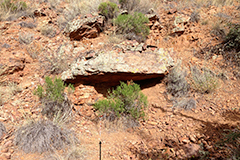 ARIZONA: Canyon Creek in eastern Arizona was one of the turquoise sources exploited by pre-Columbian indigenous groups, but it has long been considered insignificant. A new study of the area, however, has shown that the mines were actually a major supplier of the bluish-green mineral during the 13th and 14th centuries, when turquoise was exported to sites as far as 80 miles away. Lead isotope analysis of samples indicates that Canyon Creek turquoise is unique, making it distinguishable from other sources in the Southwest. —Jason Urbanus
ARIZONA: Canyon Creek in eastern Arizona was one of the turquoise sources exploited by pre-Columbian indigenous groups, but it has long been considered insignificant. A new study of the area, however, has shown that the mines were actually a major supplier of the bluish-green mineral during the 13th and 14th centuries, when turquoise was exported to sites as far as 80 miles away. Lead isotope analysis of samples indicates that Canyon Creek turquoise is unique, making it distinguishable from other sources in the Southwest. —Jason Urbanus -
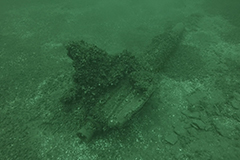 CANADA: Nearly 60 years after it disappeared, one of the models of Canada’s most legendary jet fighter, the Avro Arrow, has been discovered by an ROV in Lake Ontario. The technologically advanced plane was developed in the 1950s, but the program was suddenly scrapped in 1959, and all existing aircraft and blueprints were destroyed. The 12-foot-long, 10-foot-wide, smallscale test model had been launched over the lake to determine its flight worthiness and improve the Arrow’s final design. —Jason Urbanus
CANADA: Nearly 60 years after it disappeared, one of the models of Canada’s most legendary jet fighter, the Avro Arrow, has been discovered by an ROV in Lake Ontario. The technologically advanced plane was developed in the 1950s, but the program was suddenly scrapped in 1959, and all existing aircraft and blueprints were destroyed. The 12-foot-long, 10-foot-wide, smallscale test model had been launched over the lake to determine its flight worthiness and improve the Arrow’s final design. —Jason Urbanus -
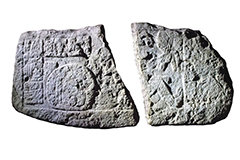 BELIZE: Ball games were an important sociopolitical aspect of Maya society, with communities often playing one another. Two carved stone panels depicting ballplayers from the site of Tipan Chen Uitz seem to commemorate one famous competition that occurred there between A.D. 600 and 800. One of the players stands beside a large ball, wears a protective belt, and holds a stafflike object in his hand. The hieroglyphic inscription identifies him as “Waterscroll Ocelot.” He most likely competed for the home team. —Jason Urbanus
BELIZE: Ball games were an important sociopolitical aspect of Maya society, with communities often playing one another. Two carved stone panels depicting ballplayers from the site of Tipan Chen Uitz seem to commemorate one famous competition that occurred there between A.D. 600 and 800. One of the players stands beside a large ball, wears a protective belt, and holds a stafflike object in his hand. The hieroglyphic inscription identifies him as “Waterscroll Ocelot.” He most likely competed for the home team. —Jason Urbanus -
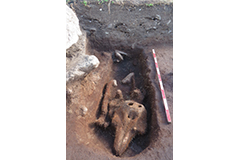 GUERNSEY: Archaeologists are baffled by a 14th-century burial on Chapelle Dom Hue, a small islet once used as a monastic retreat. Because the grave was so well constructed, researchers initially believed it belonged to a human and were shocked when they encountered the bones of a porpoise. Although these marine mammals were eaten during medieval times, it is not known why the remains were buried in such a careful matter, suggesting perhaps that the porpoise had some kind of religious significance. —Jason Urbanus
GUERNSEY: Archaeologists are baffled by a 14th-century burial on Chapelle Dom Hue, a small islet once used as a monastic retreat. Because the grave was so well constructed, researchers initially believed it belonged to a human and were shocked when they encountered the bones of a porpoise. Although these marine mammals were eaten during medieval times, it is not known why the remains were buried in such a careful matter, suggesting perhaps that the porpoise had some kind of religious significance. —Jason Urbanus -
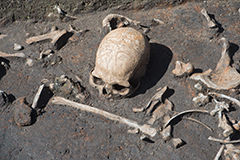 GERMANY: One of Europe’s oldest battlefields is located in northeast Germany’s Tollense River Valley. Around 3,250 years ago, a clash involving some 2,000 warriors left a mile-long stretch of the river littered with weapons and dead bodies. Recent isotopic analysis of tooth enamel was able to narrow down the geographic origins of the combatants. While one group was local to the region, scientists determined that a second group was made up of diverse individuals who had traveled from southern Germany or central Europe to join the battle. —Jason Urbanus
GERMANY: One of Europe’s oldest battlefields is located in northeast Germany’s Tollense River Valley. Around 3,250 years ago, a clash involving some 2,000 warriors left a mile-long stretch of the river littered with weapons and dead bodies. Recent isotopic analysis of tooth enamel was able to narrow down the geographic origins of the combatants. While one group was local to the region, scientists determined that a second group was made up of diverse individuals who had traveled from southern Germany or central Europe to join the battle. —Jason Urbanus -
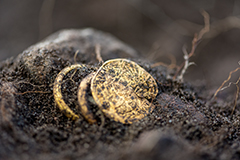 SWEDEN: Several valuable objects unearthed at the Sandby Borg ringfort on the island of Öland may finally provide more clues about a massacre that occurred there 1,500 years ago. Several of the settlement’s inhabitants, including children, were slaughtered in the 5th century, but it is not known why. The recent discovery of a Roman gold coin, two gold rings, and Roman glass indicates that the islanders maintained close ties with the empire and were quite wealthy, which may have fostered resentment among rival communities. —Jason Urbanus
SWEDEN: Several valuable objects unearthed at the Sandby Borg ringfort on the island of Öland may finally provide more clues about a massacre that occurred there 1,500 years ago. Several of the settlement’s inhabitants, including children, were slaughtered in the 5th century, but it is not known why. The recent discovery of a Roman gold coin, two gold rings, and Roman glass indicates that the islanders maintained close ties with the empire and were quite wealthy, which may have fostered resentment among rival communities. —Jason Urbanus -
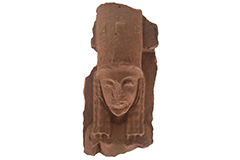 CRETE: The Anavlochos massif in east central Crete had important religious significance for communities living around it thousands of years ago. Two areas with large deposits of votive material were recently uncovered near the summit. One of the deposits contained over 350 female figurines that were purposefully deposited in cracks in the bedrock throughout the first millennium b.c. Experts are still unsure why this particular spot was chosen, but they believe the statuettes were offerings left by women during religious festivals.
CRETE: The Anavlochos massif in east central Crete had important religious significance for communities living around it thousands of years ago. Two areas with large deposits of votive material were recently uncovered near the summit. One of the deposits contained over 350 female figurines that were purposefully deposited in cracks in the bedrock throughout the first millennium b.c. Experts are still unsure why this particular spot was chosen, but they believe the statuettes were offerings left by women during religious festivals. -
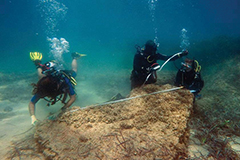 TUNISIA: After seven years of searching, the long-lost submerged Roman city of Neapolis was discovered off the coast of Nabeul. Thanks to unexpectedly clear conditions, divers were able to explore the streets and buildings of the nearly 50-acre site. Amid the ruins, they counted nearly 100 tanks used to produce garum, a popular Roman fermented fish sauce of the time. Neapolis was partially destroyed by a tsunami in a.d. 365, an event recorded by the Roman historian Ammianus Marcellinus. —Jason Urbanus
TUNISIA: After seven years of searching, the long-lost submerged Roman city of Neapolis was discovered off the coast of Nabeul. Thanks to unexpectedly clear conditions, divers were able to explore the streets and buildings of the nearly 50-acre site. Amid the ruins, they counted nearly 100 tanks used to produce garum, a popular Roman fermented fish sauce of the time. Neapolis was partially destroyed by a tsunami in a.d. 365, an event recorded by the Roman historian Ammianus Marcellinus. —Jason Urbanus -
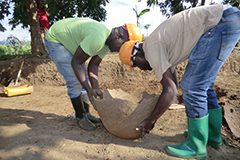 RWANDA: Excavations have begun at a palace built by King Kigeli IV Rwabugiri in 1874. The royal residence, situated near the shore of Lake Kivu in Western Province, was often frequented by the king as he hosted feasts and celebrations. Archaeologists are hoping to learn more about the physical layout of the complex and gain insight into the activities that occurred there, as part of an effort to collect and preserve more of Rwanda’s cultural heritage. —Jason Urbanus
RWANDA: Excavations have begun at a palace built by King Kigeli IV Rwabugiri in 1874. The royal residence, situated near the shore of Lake Kivu in Western Province, was often frequented by the king as he hosted feasts and celebrations. Archaeologists are hoping to learn more about the physical layout of the complex and gain insight into the activities that occurred there, as part of an effort to collect and preserve more of Rwanda’s cultural heritage. —Jason Urbanus -
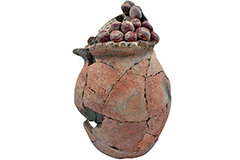 ISRAEL: A unique 7,000-year-old ceramic vessel from the site of Tel Tsaf in the Jordan Valley may have been used in early food rituals associated with grain storage. The site contains numerous silos that are believed to be the oldest large-scale storage containers that existed in the region at the time. Experts think the unusual pot, which is topped with red-painted clay balls and resembles a miniature silo, was used during ceremonies that preceded the placement or removal of grain. —Jason Urbanus
ISRAEL: A unique 7,000-year-old ceramic vessel from the site of Tel Tsaf in the Jordan Valley may have been used in early food rituals associated with grain storage. The site contains numerous silos that are believed to be the oldest large-scale storage containers that existed in the region at the time. Experts think the unusual pot, which is topped with red-painted clay balls and resembles a miniature silo, was used during ceremonies that preceded the placement or removal of grain. —Jason Urbanus
Advertisement
IN THIS ISSUE
From the Trenches
The Secrets of Sabotage
Off the Grid
A Monumental Find
The Pink Standard
Hot Property
Spotting the Sun
Bronze Beauty
Masked Man
Queen of the Old Kingdom
Underground Party
Assyrian Archivists
Unknown Elites
Front Row Seats
Irish Vikings
World Roundup
Canadian model airplane, ball games in Belize, Roman Tunisia, Arizona turquoise mines, and a Rwandan palace
Artifact
A dog that heals
Advertisement

Recent Issues
-
 May/June 2024
May/June 2024
-
 March/April 2024
March/April 2024
-
 January/February 2024
January/February 2024
-
 November/December 2023
November/December 2023
-
 September/October 2023
September/October 2023
-
 July/August 2023
July/August 2023
-
 May/June 2023
May/June 2023
-
 March/April 2023
March/April 2023
-
 January/February 2023
January/February 2023
-
 November/December 2022
November/December 2022
-
 September/October 2022
September/October 2022
-
 July/August 2022
July/August 2022
-
 May/June 2022
May/June 2022
-
 March/April 2022
March/April 2022
-
 January/February 2022
January/February 2022
-
 November/December 2021
November/December 2021
-
 September/October 2021
September/October 2021
-
 July/August 2021
July/August 2021
-
 May/June 2021
May/June 2021
-
 March/April 2021
March/April 2021
-
 January/February 2021
January/February 2021
-
 November/December 2020
November/December 2020
-
 September/October 2020
September/October 2020
-
 July/August 2020
July/August 2020
-
 May/June 2020
May/June 2020
-
 March/April 2020
March/April 2020
-
 January/February 2020
January/February 2020
-
 November/December 2019
November/December 2019
-
 September/October 2019
September/October 2019
-
 July/August 2019
July/August 2019
-
 May/June 2019
May/June 2019
-
 March/April 2019
March/April 2019
-
 January/February 2019
January/February 2019
-
 November/December 2018
November/December 2018
-
 September/October 2018
September/October 2018
-
 July/August 2018
July/August 2018
-
 May/June 2018
May/June 2018
-
 March/April 2018
March/April 2018
-
 January/February 2018
January/February 2018
-
 November/December 2017
November/December 2017
-
 September/October 2017
September/October 2017
-
 July/August 2017
July/August 2017
-
 May/June 2017
May/June 2017
-
 March/April 2017
March/April 2017
-
 January/February 2017
January/February 2017
-
 November/December 2016
November/December 2016
-
 September/October 2016
September/October 2016
-
 July/August 2016
July/August 2016
-
 May/June 2016
May/June 2016
-
 March/April 2016
March/April 2016
-
 January/February 2016
January/February 2016
-
 November/December 2015
November/December 2015
-
 September/October 2015
September/October 2015
-
 July/August 2015
July/August 2015
-
 May/June 2015
May/June 2015
-
 March/April 2015
March/April 2015
-
 January/February 2015
January/February 2015
-
 November/December 2014
November/December 2014
-
 September/October 2014
September/October 2014
-
 July/August 2014
July/August 2014
-
 May/June 2014
May/June 2014
-
 March/April 2014
March/April 2014
-
 January/February 2014
January/February 2014
-
 November/December 2013
November/December 2013
-
 September/October 2013
September/October 2013
-
 July/August 2013
July/August 2013
-
 May/June 2013
May/June 2013
-
 March/April 2013
March/April 2013
-
 January/February 2013
January/February 2013
-
 November/December 2012
November/December 2012
-
 Sep/Oct 2012
Sep/Oct 2012
-
 September/October 2012
September/October 2012
-
 July/August 2012
July/August 2012
-
 May/June 2012
May/June 2012
-
 March/April 2012
March/April 2012
-
 January/February 2012
January/February 2012
-
 November/December 2011
November/December 2011
-
 September/October 2011
September/October 2011
-
 July/August 2011
July/August 2011
-
 May/June 2011
May/June 2011
-
 March/April 2011
March/April 2011
-
 January/February 2011
January/February 2011
Advertisement






